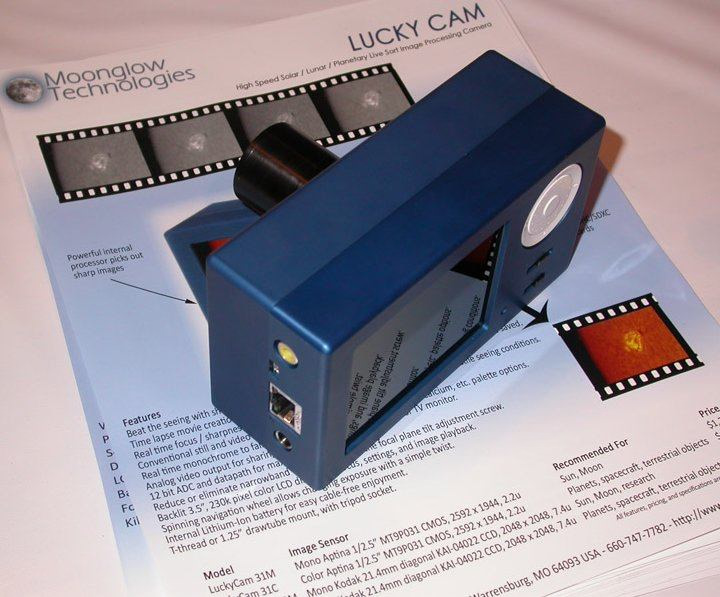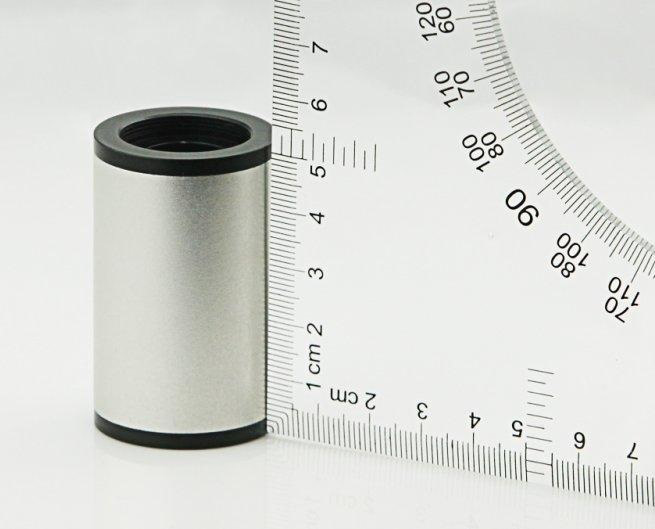New planetary cameras announced in USA, China and in Germany

Lucky Cam is a no-pc-required camera that saves only good frames to a SD card. There will be four cameras - two color and two mono. They will use two sensors - Aptina CMOS - MT9P031 and Kodak CCD - KAI-4022. For Solar System imaging that SD card will have to be big, the battery strong and the UI must be very handy to use so that multi-filter imaging or focusing won't be annoying.
Announced sensors aren't the best thing you could put for a "planetary" camera. Both sensors are more suited for low resolution lunar and solar imaging than for high-resolution planetary and lunar imaging. KAI-4022 is available in DS cameras and such independent camera with that sensor would be much more interesting for DS imaging (and it won't be cheap).
There isn't much more than some pics from NEAF but the Micron/Aptina MT9P031 based camera will cost around 1300 USD. Comparing directly to DMK72 (the same sensor, laptop required) it's more than twice the price! KAI based camera will cost whooping 6000 USD. It should provide cooled and long exposure imaging capabilities to be a good product worth buying. Also why mono cameras can't be used for planetary imaging? ;)
In China QHY announced a new line of their guide cameras - QHY5-II:

Changes applied to the new line are thin, 1,25" housing (like SX Lodestar or SBIG ST-i), faster data transfer and fixed banding artifacts at short exposures. ST4 and USB ports are still there.
- QHY5-II: 1.3mega pixel Mono 1/2inch
- QHY5T-II: 3.0mega pixel Color 1/2inch
- QHY5V-II: 752*480 color/mono 1/3inch global shutter
- QHY5U-II: 752*480 color/mono 1/3inch global shutter
- QHY5P-II: 5.0 mega pixel Color/Mono 1/2.5inch
- QHY5X-II: 10.0 mega pixel Color 1/2.3inch
- QHY5F-II: 14.0 mega pixel Color 1/2.3inch
The whole line is based on Aptina/Micron cheap CMOS sensors. They aren't state-of-the-art sensors, but they are cheap, so QHY should keep the low prices QHY5 has now. New camera - QHY5P-II is third (after DMK72 and Lucky Cam) to offer MT9P031 - a sensor with big amount of small pixels. The mono version has quite good sensitivity (QE), but still you have to look out for the rolling shutter. Good for "low resolution" solar and lunar imaging, but on the web you will also see some planetary images done with DMK72 operation on a small and fast ROI mode.
The 10 and 14 mpix color cameras use CMOS sensors with extremely small pixels (around 1 micron). Those are used only for microscope cameras. Aside of cameras - the software needs updates too. It would be good if those cameras would be fully supported by SharpCap or even FireCapture by one of generic interfaces.
And news from Germany. We are still waiting for Ximea USB 3 cameras. EV76C560 based cameras should be released this month with a interesting price of just around 240 EUR (it may have changed). With proper software it could a solar system killer cam. Also Basler Ace and Ximea cams equipped with big mono CMOSIS CMV4000 haven't been released yet. Those sensors could be very hot for big solar scopes.
Comment article